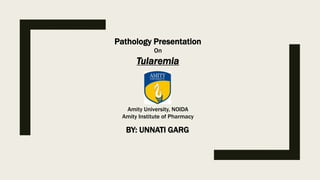
Tularemia
- 1. Pathology Presentation On Tularemia Amity University, NOIDA Amity Institute of Pharmacy BY: UNNATI GARG
- 2. Introduction ■ Tularemia also known as rabbit fever, is an infectious disease of animals and humans caused by the bacterium Francisella tularensis. ■ Rabbits, hares, and rodents are especially susceptible and often die in large numbers during outbreaks.
- 3. Infection in Humans Humans can become infected through several routes, including: ■ Tick and deer fly bites ■ Skin contact with infected animals ■ Ingestion of contaminated water ■ Inhalation of contaminated aerosols or agricultural dusts ■ Laboratory exposure ■ In addition, humans could be exposed as a result of bioterrorism.
- 4. Pathogenesis ■ Infection with F. tularensis can occur by several routes. Portals of entry are through blood and the respiratory system. The most common occurs via skin contact, yielding an ulceroglandular form of the disease. Inhalation of bacteria - particularly biovar F. t. tularensis, leads to the potentially lethal pneumonic tularemia. While the pulmonary and ulceroglandular forms of tularemia are more common, other routes of inoculation have been described and include oropharyngeal infection due to consumption of contaminated food and conjunctival infection due to inoculation at the eye. ■ F. tularensis is capable of surviving outside of a mammalian host for weeks at a time and has been found in water, grassland, and haystacks. Aerosols containing the bacteria may be generated by disturbing carcasses due to brush cutting or lawn mowing; as a result, tularemia has been referred to as "lawnmower disease". Recent epidemiological studies have shown a positive correlation between occupations involving the above activities and infection with F. tularensis.
- 5. Lifecycle ■ F. tularensis is a facultative intracellular bacterium that is capable of infecting most cell types, but primarily infects macrophages in the host organism. Entry into the macrophage occurs by phagocytosis and the bacterium is sequestered from the interior of the infected cell by a phagosome. F. tularensis then breaks out of this phagosome into the cytosol and rapidly proliferates. Eventually, the infected cell undergoes apoptosis, and the progeny bacteria are released to initiate new rounds of infection. Fig : Francisella tularensis bacteria (blue) infecting a macrophage (yellow)
- 6. Signs & Symptoms The signs and symptoms of tularemia vary depending on how the bacteria enter the body. Illness ranges from mild to life-threatening. All forms are accompanied by fever, which can be as high as 104 °F. Main forms of this disease are listed below: Fig : Ulceroglandular Tularemia • Ulceroglandular : This is the most common form of tularemia and usually occurs following a tick or deer fly bite or after handing of an infected animal. A skin ulcer appears at the site where the bacteria entered the body. The ulcer is accompanied by swelling of regional lymph glands, usually in the armpit or groin. • Glandular : Similar to ulceroglandular tularemia but without an ulcer. Also generally acquired through the bite of an infected tick or deer fly or from handling sick or dead animals.
- 7. ■ Oropharyngeal : This form results from eating or drinking contaminated food or water. Patients with orophyangeal tularemia may have sore throat, mouth ulcers, tonsillitis, and swelling of lymph glands in the neck. ■ Pneumonic : This is the most serious form of tularemia. Symptoms include cough, chest pain, and difficulty breathing. This form results from breathing dusts or aerosols containing the organism. It can also occur when other forms of tularemia (e.g. ulceroglandular) are left untreated and the bacteria spread through the bloodstream to the lungs. ■ Typhoidal : This form is characterized by any combination of the general symptoms. ■ Oculoglandular : This form occurs when the bacteria enter through the eye. This can occur when a person is butchering an infected animal and touches his or her eyes. Symptoms include irritation and inflammation of the eye and swelling of lymph glands in front of the ear. Fig : Oropharyngeal Tularemia Fig : Oculoglandular Tularemia
- 8. Diagnosis & Treatment ■ Tularemia can be difficult to diagnose. It is a rare disease, and the symptoms can be mistaken for other, more common, illnesses. For this reason, it is important to share with your health care provider any likely exposures, such as tick and deer fly bites, or contact with sick or dead animals. ■ Blood tests and cultures can help confirm the diagnosis. Antibiotics used to treat tularemia include streptomycin, gentamicin, doxycycline, and ciprofloxacin. Treatment usually lasts 10 to 21 days depending on the stage of illness and the medication used. Although symptoms may last for several weeks, most patients completely recover.
- 9. Prevention ■ When hiking, camping or working outdoors: – Use insect repellents containing 20% to 30% DEET (N,N-diethyl-meta- toluamide), picaridin or IR3535. EPA provides information on the proper use of repellents. – Wear long pants, long sleeves, and long socks to keep ticks and deer flies off your skin. – Remove attached ticks promptly with fine-tipped tweezers. – Don’t drink untreated surface water. ■ When mowing or landscaping: – Don’t mow over sick or dead animals. When possible, check the area for carcasses prior to mowing. – Use of masks during mowing and other landscaping activities may reduce your risk of inhaling the bacteria, but this has not been studied.
- 10. ■ If you hunt, trap or skin animals: – Use gloves when handling animals, especially rabbits, muskrats, prairie dogs, and other rodents. – Cook game meat thoroughly before eating. Until recently, a vaccine has been available to protect laboratorians routinely working with Francisella tularensis. This vaccine is currently under review by the US Food and Drug Administration (FDA) and is not generally available in the United States.
